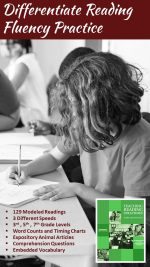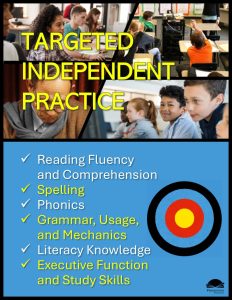
Differentiate Reading Fluency Practice
Educators value the importance of reading fluency practice. High fluency scores are positively correlated with high reading comprehension scores. The converse is true as well. Repeated reading practice and reading along with modeled readings have shown to increase accuracy, speed, intonation, expression, and attention to punctuation. Additionally, practicing along with modeled readings at a slightly faster pace than students’ assessed word counts per minute seems to help students push through habituated reading speeds to read faster with greater automaticity.
Of course, to differentiate reading fluency practice, the teacher needs to have have completed a diagnostic reading fluency for each child. My “Pets” Fluency Assessment is free to use and has a unique tiered design from easy to hand, ensuring that the teacher will be able to assess approximate reading level in addition to word count and accuracy.

Two 15-Minute Instructional Fluency Options:
Tech-Based and Print
- Individualized Instruction with Modeled Readings Online. 123 YouTube expository passages recorded at the three different “challenge level” reading speeds (available in the value-priced Reading Fluency and Comprehension Toolkit or in The Science of Reading Intervention Program). Each passage has been constructed in the tiered design. The same passage is used for vocabulary and comprehension practice with 5 embedded questions per passage.
- Small Ability Group Instruction with Print Copies of Reading Fluency Passages. These procedures have been field tested in grades 4, 5, 6, 7, and 8 classes.
- Show students a list of the fluency groups on the board or display and place an asterisk by the first Fluency Leader chosen for each group. Inform students that you will rotate Fluency Leaders and that these students have two duties: Collect and return the group materials and ask the teacher when a student in their group needs help or has a question. Ask the Fluency Leaders to get the materials (fluency folders, pencil box, and one fluency passage) for each student in their groups.
- Have students each create their own fluency folders (a simple file folder is fine) and put a bar graph inside the folders. A quick web search will bring dozens of fluency bar graphs for your selection. Select a bar graph that best matches the fluency speeds of your students. If in doubt, pick the higher level bar graph, because students tend to “overestimate” their scores on the fluency timings. Collect the fluency folders.
- As the Fluency Leaders gather and distribute the materials, show students the location of their fluency group and the desk/tables and chairs configuration on the board or overhead. Tell students that they will move desks/tables and chairs to form their fluency groups as shown. To signal readiness, the students will raise their hands. Inform them that fluency groups will receive participation points and incentives for “quick, quiet, and cooperative” transitions. Tell students to now move into their fluency groups.
- When all groups are ready, award participation points for “quick, quiet, and cooperative” transitions. Tell students that they will read the fluency passage out loud, but softly, for a two-minute timed “cold” (unpracticed) timing. Ready the stopwatch or use the second hand of the clock to time. Say– “Point to the first word of the fluency passage. Ready, begin.” As students read, monitor the groups to ensure that students are reading quietly, but above a whisper. All words must be said out loud for effective practice. After two minutes, say “Stop and Record.”
- Tell students to tally their words and record their “cold timing” score on the fluency bar graph in pencil. Model how to record the timings on the board or overhead. Inform students that after they finish recording the “cold timing,” they are to continue reading where they left off, then re-read the passage over and over until the teacher visits their group.
- Visit the lowest level fluency group and quickly pre-teach a few challenging words from the passage by saying the word and asking students to repeat the word. Briefly define the words, if they are necessary to the meaning of the fluency passage.
- Tell students that the Fluency Leader will lead the group at the reading pace set by the teacher and finish choral reading the fluency passage. Have the Fluency Leader say “Ready, begin” and begin reading. When the group is following the direction of the Fluency Leader and is reading at the appropriate rate, move on to the next group. Afterwards, the group is to re-play the YouTube video or chorally re-read the whole passage together one more time.
- After the second fluency practice, students are to individually re-read the passage out loud as fast as they feel comfortable until the teacher says, “Stop.”
- After the last group visited by the teacher has completed its choral readings, interrupt the class to complete a two-minute “hot” reading of the passage. Have students tally their words per minute and record their score in pen on the fluency bar graph, directly above the “cold” timing.
- Tell Fluency Leaders to collect materials, while the groups re-organize the desks/tables. When all students have returned to their seats and all materials have been properly collected, award participation points for “quick, quiet, and cooperative” transitions.
Helpful Hints
Work on attention to punctuation and expression. Students should read softly, but above a whisper. An entire class reading at this level provides a “white noise” that promotes individual concentration. Play the YouTube videos at reasonable volume levels or use headphones.
Assess progress by examining the day to day recorded “cold” readings. Although students may tend to “inflate” their “cold” and “hot” timing differentials, emphasize improvement in the “cold” timings over time.
Use your Fluency Leaders! Only Fluency Leaders get out of their seats during Fluency Remediation to gather materials or ask the teacher questions.
Integrate fluency and comprehension instruction. Teach students to “talk to the text” as they read to improve concentration and understanding. Periodically do a “Think-Aloud” to model interactive, metacognitive reading. Teach comprehension questions that will emphasize reader independence.
Also tie in vocabulary development by having the students write context clue sentences for the vocabulary words that you pre-teach.
With these procedures, your fluency groups will thrive and students will significantly improve their reading fluency.
*****

The Science of Reading Intervention Program
The Science of Reading Intervention Program: Word Recognition includes explicit, scripted instruction and practice with the 5 Daily Google Slide Activities every reading intervention student needs: 1. Phonemic Awareness and Morphology 2. Blending, Segmenting, and Spelling 3. Sounds and Spellings (including handwriting) 4. Heart Words Practice 5. Sam and Friends Phonics Books (decodables). Plus, digital and printable sound wall cards and speech articulation songs. Print versions are available for all activities. First Half of the Year Program (55 minutes-per-day, 18 weeks)
The Science of Reading Intervention Program: Language Comprehension resources are designed for students who have completed the word recognition program or have demonstrated basic mastery of the alphabetic code and can read with some degree of fluency. The program features the 5 Weekly Language Comprehension Activities: 1. Background Knowledge Mentor Texts 2. Academic Language, Greek and Latin Morphology, Figures of Speech, Connotations, Multiple Meaning Words 3. Syntax in Reading 4. Reading Comprehension Strategies 5. Literacy Knowledge (Narrative and Expository). Second Half of the Year Program (30 minutes-per-day, 18 weeks)
The Science of Reading Intervention Program: Assessment-based Instruction provides diagnostically-based “second chance” instructional resources. The program includes 13 comprehensive assessments and matching instructional resources to fill in the yet-to-be-mastered gaps in phonemic awareness, alphabetic awareness, phonics, fluency (with YouTube modeled readings), Heart Words and Phonics Games, spelling patterns, grammar, usage, and mechanics, syllabication and morphology, executive function shills. Second Half of the Year Program (25 minutes-per-day, 18 weeks)
The Science of Reading Intervention Program BUNDLE includes all 3 program components for the comprehensive, state-of-the-art (and science) grades 4-adult full-year program. Scripted, easy-to-teach, no prep, no need for time-consuming (albeit valuable) LETRS training or O-G certification… Learn as you teach and get results NOW for your students. Print to speech with plenty of speech to print instructional components.
SCIENCE OF READING INTERVENTION PROGRAM RESOURCES HERE for detailed product description and sample lessons.
FREE DOWNLOADS TO ASSESS THE QUALITY OF PENNINGTON PUBLISHING RESOURCES: The SCRIP (Summarize, Connect, Re-think, Interpret, and Predict) Comprehension Strategies includes class posters, five lessons to introduce the strategies, and the SCRIP Comprehension Bookmarks.
Get the SCRIP Comprehension Strategies FREE Resource:

Get the Diagnostic ELA and Reading Assessments FREE Resource:

Get the Pets Fluency Assessment FREE Resource:

Literacy Centers, Reading
comprehension, differentiated fluency instruction, differentiating, fluency, fluency articles, fluency passages, fluency practice, Mark Pennington, phonics, practice, Reading, Teaching Reading Strategies, timed fluency, writing fluency



